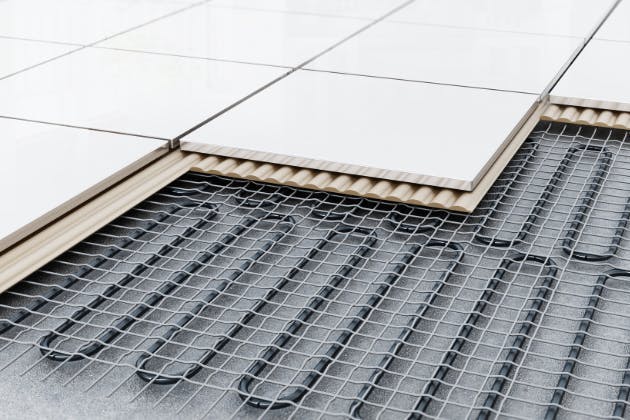Underfloor heating is a method of warming a room by installing heating elements beneath the floor surface. This innovative approach creates a comfortable, evenly distributed heat that rises naturally, providing efficient warmth throughout the space. Unlike traditional radiators that create hot and cold spots, underfloor heating ensures a consistent temperature from floor to ceiling, enhancing comfort and energy efficiency.
There are two types of underfloor heating systems available and we'll go through them in this blog.
Types of Underfloor Heating Systems
Wet Underfloor Heating Systems
Wet systems, also known as hydronic systems, use warm water circulated through a network of pipes beneath your floor. These systems are connected to your home's central heating system, typically powered by a boiler or heat pump.
Wet underfloor heating systems are highly energy-efficient, making them an excellent choice for larger areas or whole-house installations. They work particularly well with heat pumps, which can significantly reduce your carbon footprint and energy bills. The warm water circulating through the pipes provides a gentle, consistent heat that's ideal for maintaining a comfortable temperature in living areas, kitchens, and bedrooms.
One of the main advantages of wet systems is their versatility in terms of heat sources. They can be connected to gas boilers, oil boilers, heat pumps, or even solar thermal systems, giving you flexibility in how you power your heating.
However, wet systems do come with some considerations. The installation process is more complex and typically requires a greater initial investment. The pipes need to be laid before the final flooring is installed, which means they're best suited for new-build properties or major renovation projects. Additionally, the system may require the floor height to be raised slightly to accommodate the pipes and insulation.
Despite these challenges, many homeowners find that the long-term energy savings and superior comfort of wet underfloor heating systems make them a worthwhile investment.

Electric Underfloor Heating Systems
Electric underfloor heating systems use a network of heating cables or mats installed directly beneath the floor surface. These systems are powered by electricity and can be controlled independently of your home's central heating system.
One of the primary advantages of electric systems is their ease of installation. The heating elements are thin and flexible, making them less disruptive to install compared to wet systems. This makes electric underfloor heating an excellent choice for renovation projects or when adding heating to a single room, such as a bathroom or conservatory.
Electric systems also offer precise zone control, allowing you to heat specific areas of your home independently. This can be particularly useful in rooms that are used infrequently or have different heating requirements.
The initial cost of installing an electric underfloor heating system is typically lower than that of a wet system. However, it's important to consider the long-term running costs. Electricity is generally more expensive than gas in the UK, which means that electric systems can be more costly to operate, especially in larger spaces.
Electric underfloor heating is particularly well-suited to smaller areas or rooms where a quick heat response is desired. They're popular in bathrooms, where the ability to quickly warm the floor for comfort when stepping out of the shower is highly valued.
Choosing the Right System for Your Home
Selecting the most appropriate underfloor heating system for your property requires careful consideration of several factors:
Your budget
Consider both the initial installation costs and long-term running costs. While electric systems may be cheaper to install, they can be more expensive to run. Wet systems have higher upfront costs but can offer significant savings over time, especially when paired with energy-efficient heat sources.
The size of the area
For larger areas or whole-house installations, wet systems are often more cost-effective. For smaller areas or individual room upgrades, electric or dry systems might be more suitable.
The type of flooring
Different underfloor heating systems work better with certain floor types. For example, electric systems are often preferred for tile or stone floors, while wet systems work well with a variety of floor coverings.
Your home's insulation
The effectiveness of any underfloor heating system is greatly enhanced by good insulation. If your home is well-insulated, you may be able to use a lower-output system, reducing both installation and running costs.
Your existing heating system
If you already have a boiler or heat pump, a wet underfloor heating system might integrate more easily with your existing setup.
Speak with heating engineers in Fife, Dunfermline, Dundee and Edinburgh
Get in touch by calling us on 01333 631977 and we'll be happy to help.


